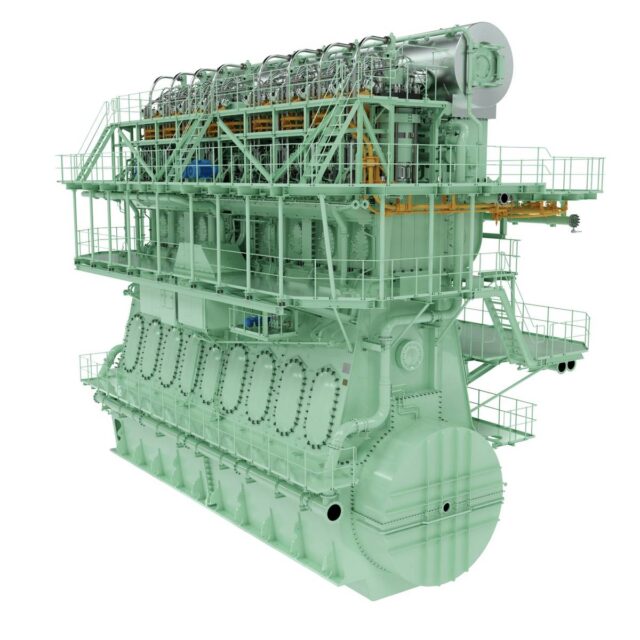Marine ammonia engines: working towards deployment in Japan
By Julian Atchison on May 07, 2024
MAN ES, Mitsui E&S, and Imabari Shipbuilding

Click to learn more. A MAN B&W 7S60ME model engine will be built in Japan and installed in a newbuild Newcastlemax vessel – one of the first deployments of MAN ES’ ammonia-fueled, two stroke engine concept. Source: MAN ES.
After almost a year of engine testing at its Copenhagen headquarters, MAN ES has announced one of the first deployments of its ammonia two-stroke engine. Mitsui E&S will build a MAN B&W 7S60ME dual-fuel engine in Japan, with Imabari Shipbuilding to then install the engine aboard a 200,000 DWT bulk carrier. An SCR catalytic converter to treat NOX emissions from ammonia fuel combustion will also be installed aboard the vessel (the first of these units was delivered in January this year from China). The ammonia-fueled, Newcastlemax-size bulk carrier is a joint venture between K Line Nihon Shipyard and Itochu. The group received AiP for the vessel design from ClassNK in November 2022. Together, the various organisations
The announcement from MAN ES represents years of steady progress. Development of ammonia-fueled engines has been ongoing since 2019, with over 100,000 hours of testing logged since that time (including a detailed testing program begun in June 2023). The announcement is also a culmination of efforts across several projects, with the various parties all coming together at the recent Singapore Maritime Week event.
This project marks another important milestone in our ammonia-engine development and indeed for the maritime industry in general. It also confirms that we are on the right track…Equally as important, we are confident of how to handle it safely; it is very satisfying to see our hard work beginning to pay off.
Brian Østergaard Sørensen, VP and Head of R&D (Two-Stroke) at MAN Energy Solutions in his organisation’s official press release, 11 Apr 2023
This first MAN B&W ammonia engine is a 60-bore type, which is applicable to a broad range of vessel segments. We believe that the success of ammonia as a marine fuel strongly relies on a safe introduction to the market. We will therefore monitor a number of engines entering operation at sea to ensure that the engine design and functionality of the auxiliary systems meet our expectations before the engine is formally introduced to our marine-engine programme as part of a full sales release. In the short term, we expect a fast uptake of ammonia-fuelled engines towards the end of the decade as we obtain positive seagoing experience from the first engines. In the long term, we expect ammonia to comprise around 35% of fuel used onboard large merchant-marine vessels by 2050 due to lower production cost compared to other e-fuels relevant for large merchant-marine vessels.
Thomas S. Hansen, Head of Sales and Promotion, MAN Energy Solutions in his organisation’s official press release, 11 Apr 2023
Wärtsilä, WinGD, Mitsubishi also moving towards deployment
First announced in December 2023, Wärtsilä and Viridis Bulk Carriers are still working towards the commercial deployment of Wärtsilä’s four-stroke, ammonia-fueled engine. Along with the engine itself, Wärtsilä has also developed all the necessary technologies for safe operations onboard a vessel, including a gaseous fuel supply system, an accidental release mitigation system, and an exhaust after-treatment system for NOX pollutants.
WinGD and China State Shipbuilding Corporation are collaborating to launch ammonia-fueled vessels in 2025-6. WinGD’s X72DF-A ammonia-fueled engines will be installed in a series of 210,000 DWT bulk carriers being built in Qingdao Beihai Shipyard, China.
And Mitsubishi Shipbuilding has confirmed an order has been placed for its new ammonia fuel supply system. The combined fuel delivery and gas abatement system will be delivered to Japan Engine Corporation in 2025 for installation aboard an midsize gas carrier, along with a domestically-built engine. NYK has led development of the vessel, which is due to hit the water in late 2026.